PRESTO PLANS
Sent straight to your inbox
CLICK HERE TO ACCESS
Sign up to receive 10 ready-to-use ELA resources your students will love!
10 FREE ELA RESOURCES
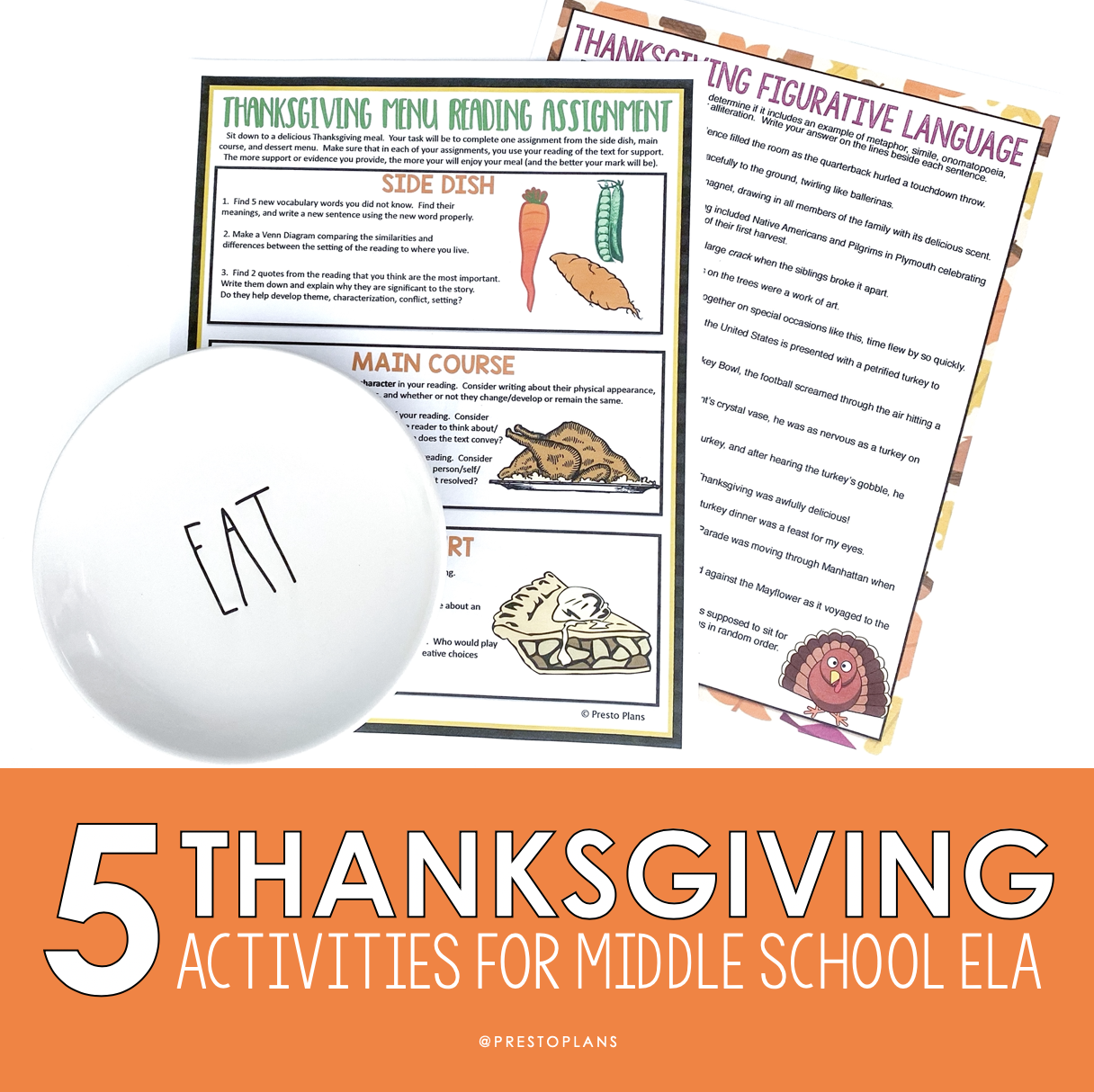
5 Thanksgiving Activities to Use in Middle School ELA
Looking for creative ways to integrate Thanksgiving activities into your middle school ELA curriculum this year? Look no further! I’ve put together a list of 5 of my favorite engaging Thanksgiving reading and writing activities that will get your students feeling thankful while developing their ELA skills at the same time!
1. Thanksgiving Figurative Language
The first activity that you might consider using is Thanksgiving figurative language. This activity will help sharpen your students’ understanding of figurative language by having them identify examples of metaphor, simile, onomatopoeia, personification, oxymoron, and alliteration from a list of Thanksgiving-inspired quotes.
Give students a list of 20 figurative language sentences that each relate to Thanksgiving in some way. And don’t stop at the turkey in your examples. You can also draw on things like Football, the changing of the leaves, the history of Thanksgiving, and anything else that connects to this holiday. Here are a few that I like to use myself…
- “The sound of silence filled the room as the quarterback hurled a touchdown throw.”
- “The leaves fell gracefully to the ground, twirling like ballerinas.”
- “The turkey was a magnet, drawing in all members of the family with its delicious scent.”
I will typically put students into pairs and have the class complete to see which pair can complete them all correctly first. This adds a fun element and students always get into it. Once students have finished, I like to go over the answers as a class. This usually leads to some meaningful Thanksgiving-related discussion!
2. Thank You, Ma’am by Langston Hughes
Langston Hughes’ short story “Thank You, Ma’am” might not be directly about Thanksgiving, but that doesn’t mean that it’s not an extremely fitting story to teach around this time of the year. As its title suggests, the spirit of the holiday is central to “Thank you, Ma’am.”
In Hughes’ story, a boy tries to steal the purse of a woman who is walking home alone at night. When the boy is unable to get away with his crime, he expects punishment. Instead, Mrs. Luella Bates Washington Jones brings him home and offers him a kindness that he will never forget.
I like to start off teaching this short story with some pre-reading discussion questions that relate to the story indirectly. This, along with a little background context on the author, helps warm students up to the ideas in the story before getting them to read the text itself.
After they’re finished reading the story, I have students complete some work with character analysis of Mrs. Jones and Roger, dive deeper into the story with some analysis questions, and end off the lesson with a creative response where students take on the role of Roger and write a letter to Mrs. Jones 10 years after their encounter.
3. Save the Turkey Persuasive Writing
Another fun Thanksgiving activity you can use in your middle school ELA classroom is save the turkey persuasive writing. For this activity, your students will have to imagine themselves as a turkey on a farm who has just heard an awful rumor: they will be the Turkey who was chosen for Thanksgiving supper! Your students will need to write convincingly in order to persuade the farmer to reconsider…
Instead of getting them to start writing right away, you can take this opportunity to give students some tips for improving their persuasive writing skills, such as:
- Factual vs Emotional Arguments: Tell students to make sure that their reasons are not just emotional, but that they are logical and based on factual elements.
- Counter Arguments: Get them to anticipate the opposing arguments and come up with something to counter that point.
- Formal vs Informal Style: Persuasive writing should have a more formal style. Encourage students to use strong vocabulary words and to avoid dead or overused words (i.e. good, bad, happy, sad, etc.).
I like to also take this opportunity to give students tips for organizing their writing. I like to have them use a persuasive pre-writing planning sheet to help them get started, and I remind them how to write a strong introduction, body paragraph, and conclusion. You can complete this activity by having students share what they wrote in front of the class. Or, you can get them to share their writing in small groups.
4. Thanksgiving Menu Assignment
The Thanksgiving menu reading assignment is the ELA equivalent to a delicious, three-course Thanksgiving supper! It involves a side dish, main course, and dessert. This Thanksgiving-themed activity can serve as the post-reading assessment for any short story or novel. Your students will complete assignments on the menu, one from each of the three courses below…
Side Dish
For the side dish, I assign students ELA skills-based tasks that they should be able to complete rather quickly. Like any great side dish, these should serve to complement the main one. Here’s an example of a side dish assignment your students’ might do:
- Make a Venn Diagram comparing the similarities and differences between the setting of the reading to where you live.
Main Course
The main course is where you can really get your students to dive deep into story elements and analyze important aspects of the text. Here’s an example of a main course menu item that you can assign your students:
- Write a paragraph about the main character in your reading. Consider writing about their physical appearance, personality traits, relationships with others, and whether they change/develop or remain the same.
Dessert
For what many would say is the best part of the meal, the dessert, I get students to respond creatively to what they are reading. Here’s an example of a dessert option that your students can choose to further connect themselves to the text:
- Write a short poem or song about the reading. It could be about an event or about a character.
These are each just one example of the different kinds of assignments you can give for the three courses, but I usually like to give them three to choose from for each course to allow for differentiation, and I supply organizers for each of the choices as well.
5. Thanksgiving Descriptive Writing
The last Thanksgiving activity I want to suggest is Thanksgiving descriptive writing. You can start this activity by giving your students a lesson on descriptive language by teaching them about the power of using imagery and comparisons (metaphor, simile, and hyperbole) in their writing.
Then, as a final project, you can get them to apply what they’ve learned by writing a descriptive paragraph on something Thanksgiving-related. Here are a few possible topics you can give them to activate their descriptive language:
-
Jumping into a pile of fall leaves
-
Thanksgiving dinner
- A football game
I also give students pre-writing worksheets that prompt them to think about the imagery and comparisons they will use in their descriptive writing. I get them to categorize each of the sensory words they will use to describe their topic next to images representing the five senses. Then, I have them write out metaphors, similes, and hyperbole that will improve the imagery of their descriptions.
If you are interested in grabbing all the resources mentioned above in a ready-to-use bundle, you can click the image below.
BONUS: Thanksgiving Reading Mystery
You can also mix things up ahead of Thanksgiving with a Thanksgiving reading mystery. Reading mysteries are a fun way to engage your students and challenge them to look for text evidence, infer information, and read more closely. Because who doesn’t love a good mystery?
The premise is that Mary is hosting the family Thanksgiving dinner, and when she takes the topper off to reveal the delicious pumpkin pie, she notices that it’s gone! Someone has eaten the whole thing, and it’s up to your students to determine who was the most likely culprit. You can click here to check out the Mystery of the Missing Pumpkin Pie here or learn more about the full-year program here.
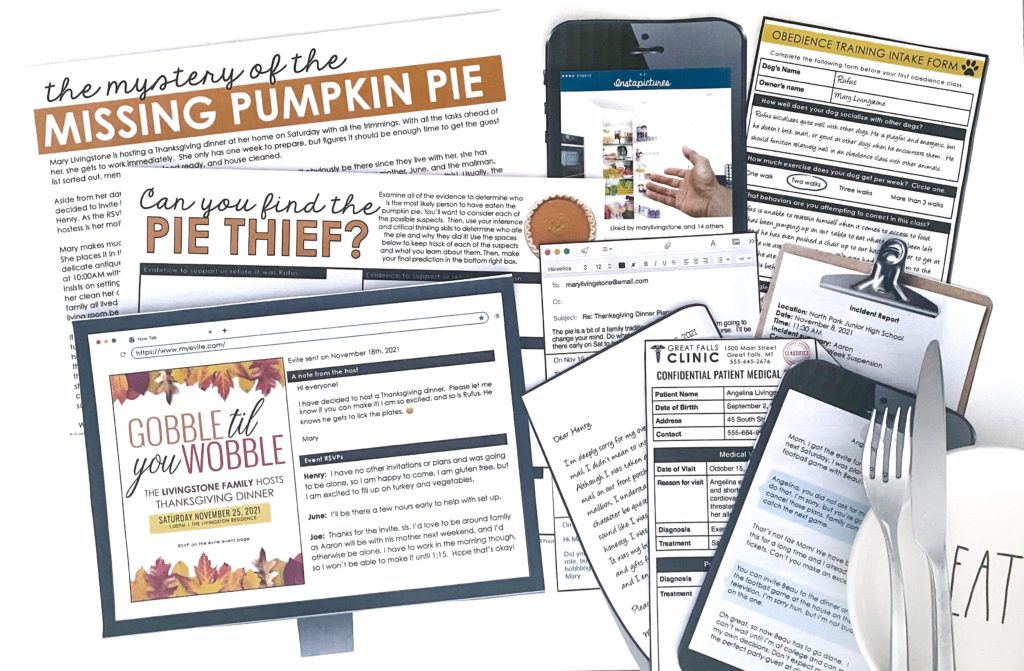
There you have it! I hope you and your students have a wonderful Thanksgiving experience in your ELA classroom! If you’re looking ahead at ELA activities for the winter, I talk about the perfect idea for you in another post.
Search the blog for what you are teaching
GIVEAWAYS
sent straight to your inbox!
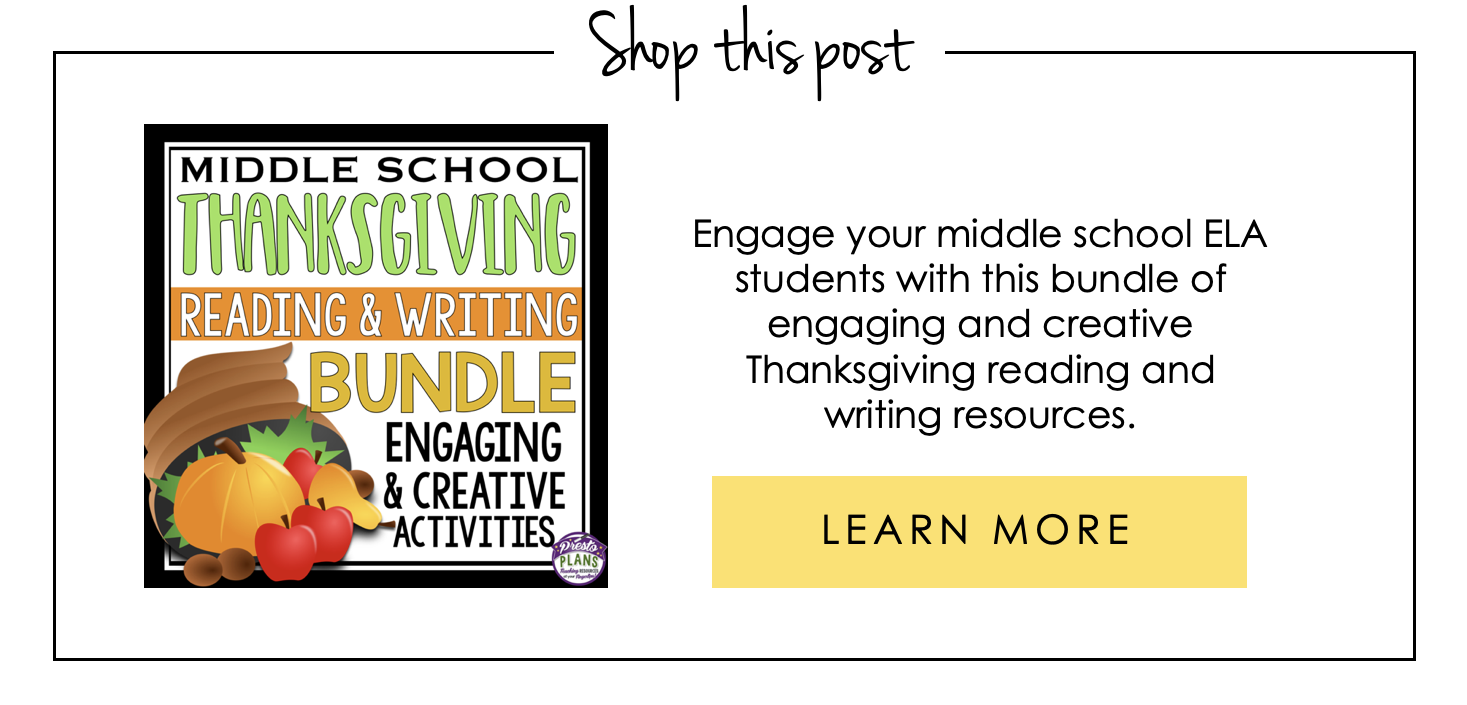
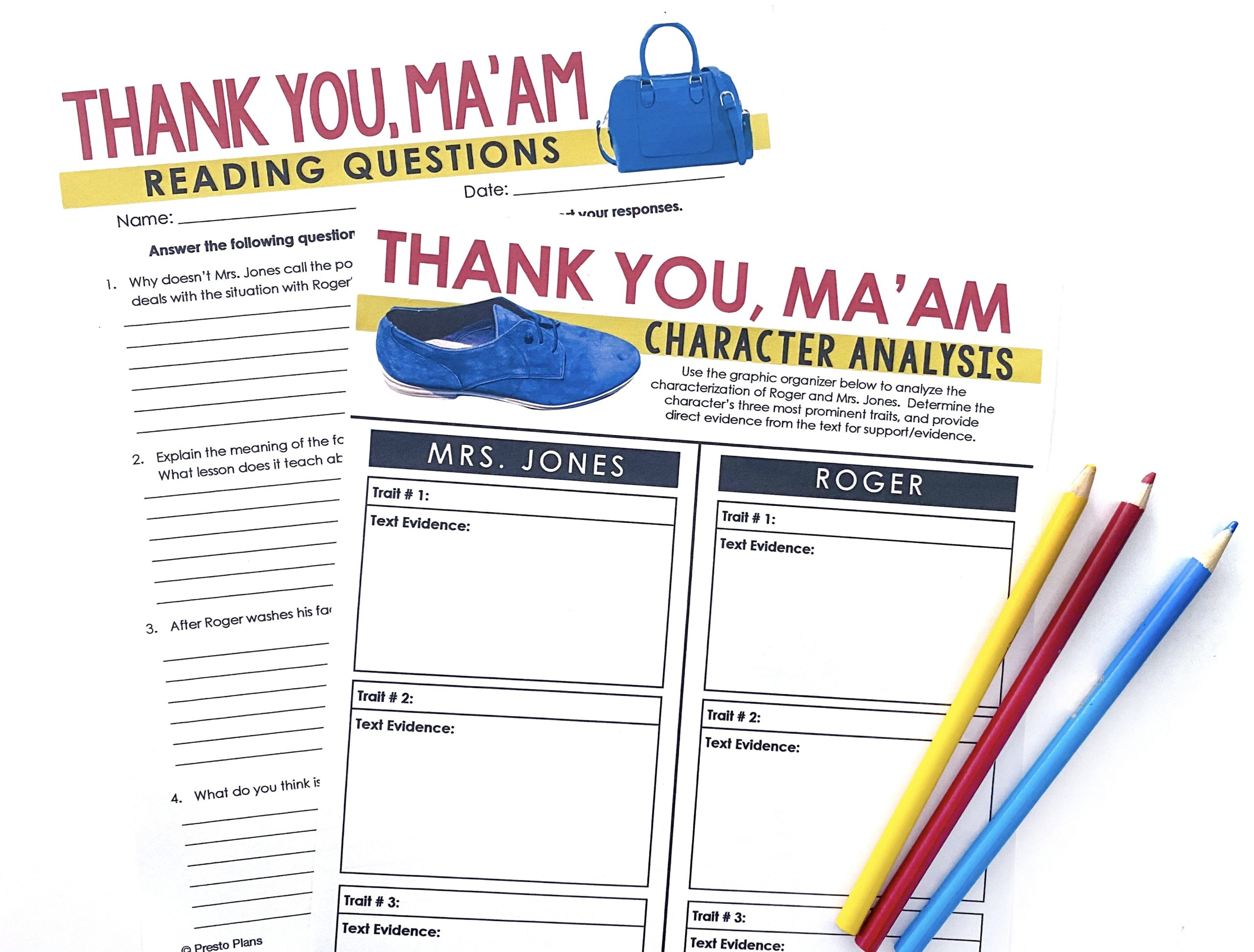
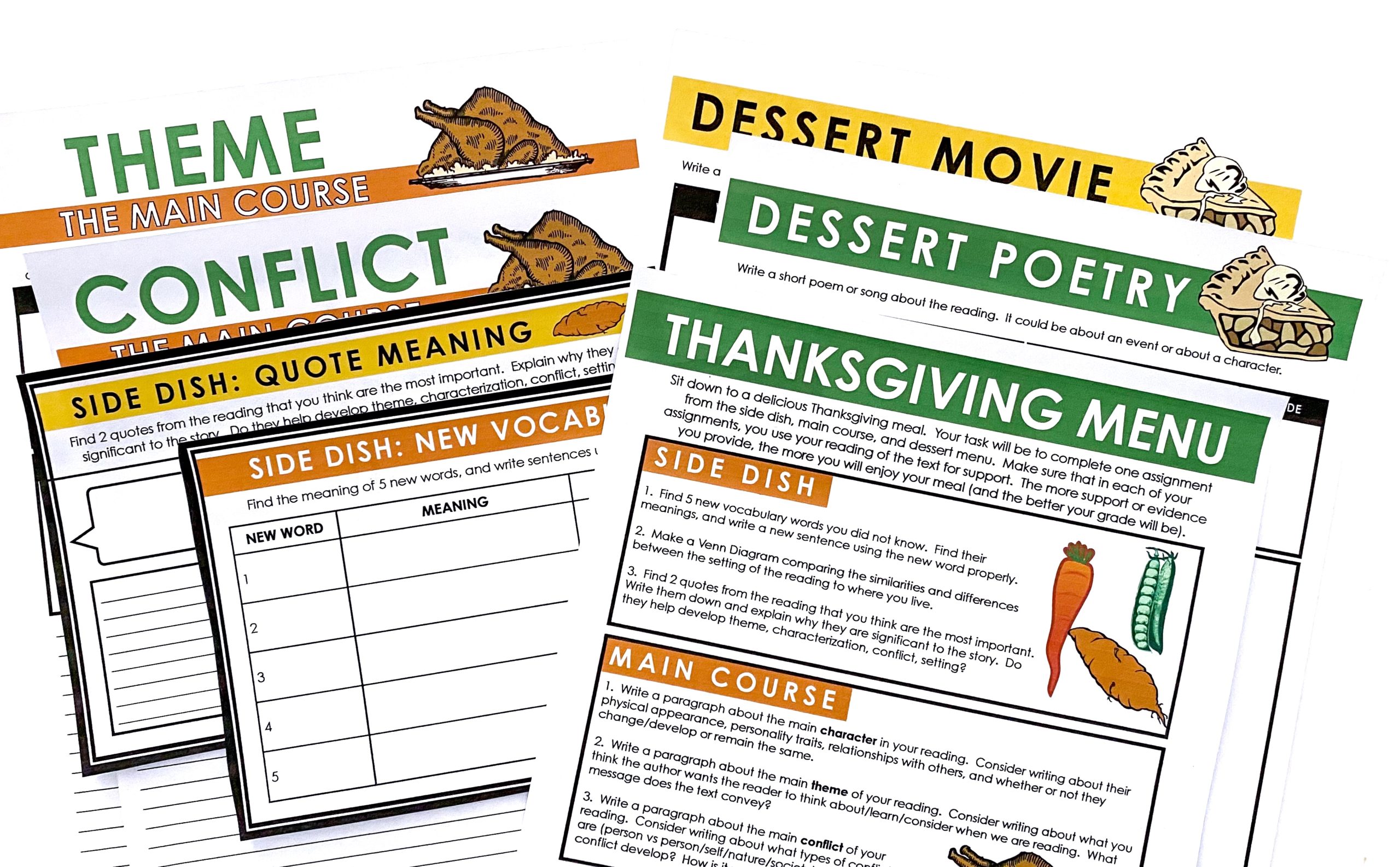
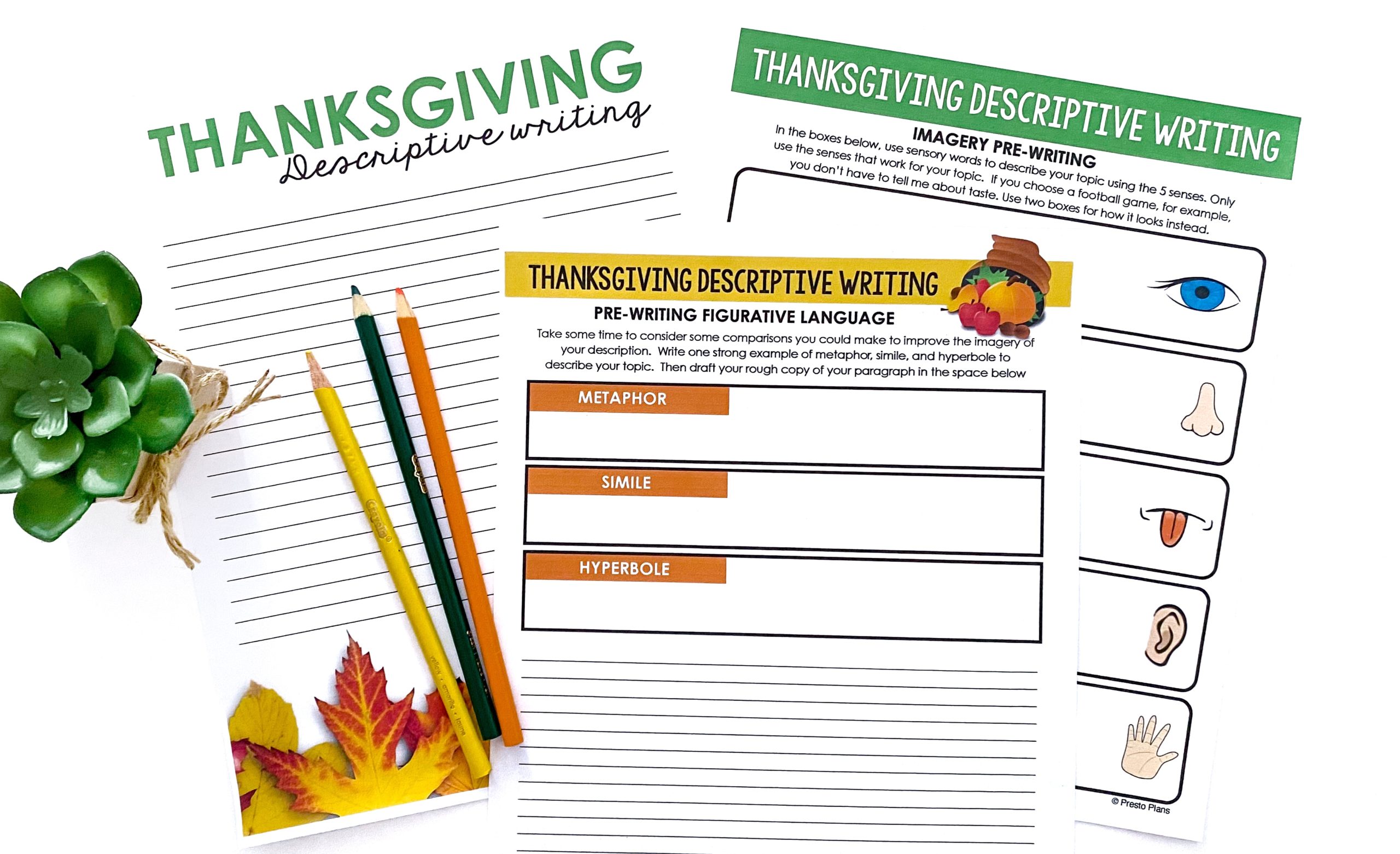
share this post